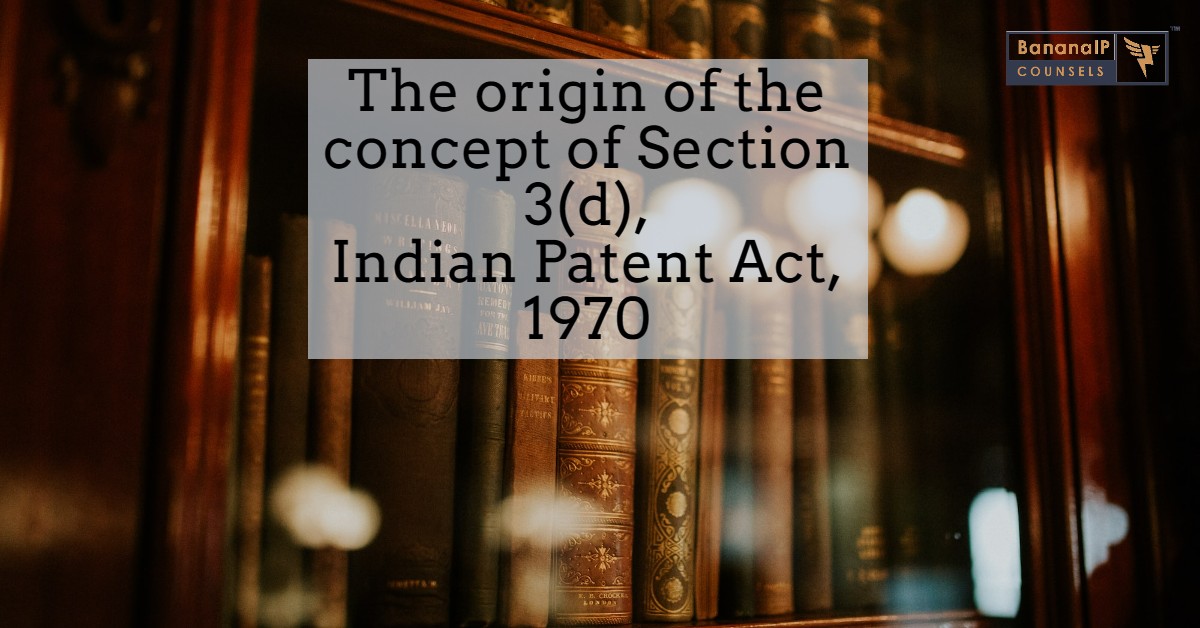Regarding pharmaceutical patents in India, Section 3(d) of The Patents Act 1970 is the most controversial and attention-sought provision, specifically after the Novartis case[i]. Like Section 3(d), the origin of Section 3(d) has also been of wide research interest, and there have been various speculations[ii]. Section 3(d) was introduced into the Indian Patents Act in the post-TRIPS (Trade related aspects of intellectual property rights) scenario, along with the product patents, to prevent the evergreening of patents.
The Section 3(d) reads as “the mere discovery of a new form of a known substance which does not result in the enhancement of the known efficacy of that substance or the mere discovery of any new property or new use for a known substance or of the mere use of a known process, machine or apparatus unless such known process results in a new product or employs at least one new reactant. Explanation- For the purposes of this clause, salts, esters, ethers, polymorphs, metabolites, pure form, particle size, isomers, mixtures of isomers, complexes, combinations and other derivatives of known substance shall be considered to be the same substance, unless they differ significantly in properties with regard to efficacy.”
When it comes to the pharmaceutical substance, the substance could be read along with Section 2(1)(ja) of the Patents Act, 1970 as “pharmaceutical substance” that means “any new entity involving one or more inventive steps”. Hence it is clear that when a new form of an active ingredient or ‘new chemical entity (NCE)’, as mentioned in the explanation of Section 3(d), is covered in a patent application, it should show details of enhanced therapeutic efficacy[iii] to grant a patent. Before the introduction of Section 3(d) in the Indian Patents Act 1970 in 2005, a similar provision existed in the regulation of Supplementary Protection Certificates (SPCs) (Revisiting Supplementary Protection Certificates of the European Union) in the E.U.
SPCs concerning the E.U pharmaceutical patents have no prima facie connection with the Indian Patents Act or Indian pharmaceutical regulatory guidelines. However, on close watch, some interconnections could be found. Article 3(c) of the Medicinal SPC Regulation states, ‘The product has not already been the subject of a certificate’. i.e., only one SPC may be granted for a product. This article is further detailed in the Explanatory Memorandum, i.e., “The proposal for a regulation, therefore, concerns only new medicinal products. It does not involve granting a certificate for medicinal products that are authorised to be placed on the market. Only one certificate may be granted for any one product. a product being understood to mean an active substance in the strict sense. Minor changes to the medicinal product such as a new dose, the use of a different salt or ester or a different pharmaceutical form will not lead to the issue of a new certificate.” [iv] One can easily infer that section 3(d) of the Indian Patent Act of 1970 could have been inspired by the explanatory memorandum for SPCs of 1990. However, efficacy part of section 3(d) of the Indian Patents act stands unique. Moreover, both intend to prevent evergreening, one on SPCs and the other on patents.
[i] Novartis AG v. Union of India & Others, (2013) 6 SCC 1
[ii] Prashant Reddy, Pages from history: The mysterious legislative history of Section 3(d), De-Coding Indian Intellectual Property Law, SpicyIP, November 9, 2011 https://spicyip.com/2011/11/pages-from-history-mysterious.html
[iii] Novartis AG v. Union of India & Others, (2013) 6 SCC 1
[iv] Proposal for a COUNCIL REGULATION (EEC) concerning the creation of a supplementary protection certificate for medicinal products, COMMISSION OF THE EUROPEAN COMMUNITIES COM (90) 101 final – SYN 255 Brussels, 11th April, 1990 – Definition of “product” in Article 1(b) and e.g. section 11 of the Explanatory Memorandum.
Authored by Muhammed Faris V (Intern, BananaIP Counsels).



